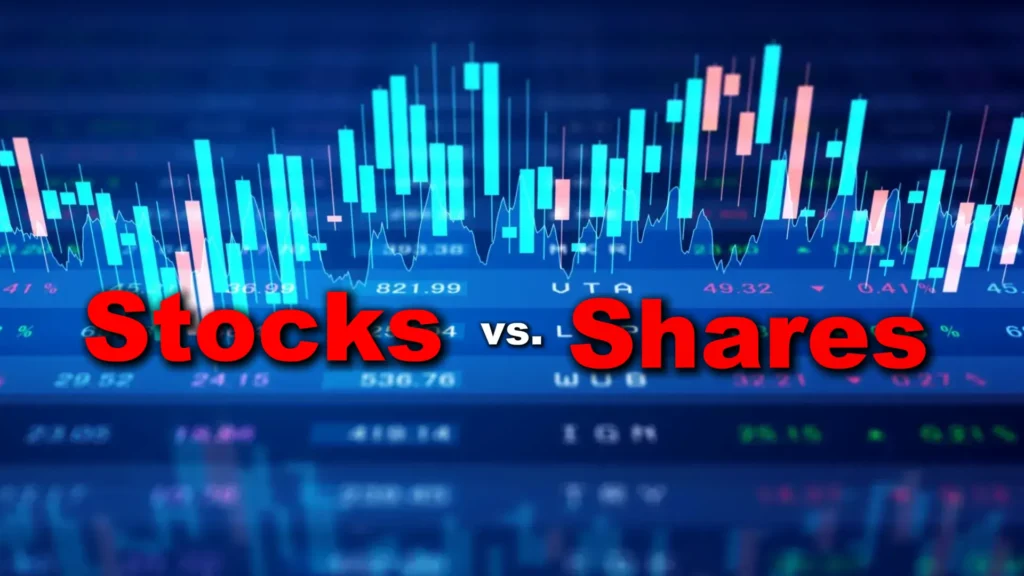In 2023, over 58% of U.S. adults owned stocks through direct purchases or retirement accounts. That’s more than 150 million people. With so many involved in the market, it’s important to understand what they’re actually buying. Two terms—stock and share—are used all the time, but they aren’t the same thing.
Many people use these words in the same way. They say “buying stocks” or “owning shares” without thinking twice. But there is a small and important difference between them. Knowing this difference helps investors understand the market better.
The Difference Lies in The Basics of Ownership
When someone invests in a company, they become part-owner. This ownership is possible because companies split their value into small units. These units are known as shares. If you buy one unit, you own one share in that company.
The total group of these units is called stock. So, if a company has 1,000 units and you own 10, you own 10 shares of that company’s stock. A person can own shares in different companies. When we talk about the full range of shares a person owns, we use the word stock.
Stock Means General Ownership
Stock is a broad term. It refers to an investor’s total investment in companies. For example, someone may say, “I own tech stocks.” This means they own shares in one or more tech companies.
Stock can describe a category of investment. It can mean part-ownership in a business. It can also be used when the exact company or number of units is not important. The term is used to describe someone’s overall position in the market.
People use the word stock when talking about the market as a whole. Headlines often report that “stocks fell today” or that “the stock market is up.” This use of the term doesn’t point to any one company. It means many companies combined.
Share Means Specific Units
A share is a single unit of ownership. If you own 20 shares of Company A, you own 20 units of that business. Each unit has a price. If one share costs $50, your total investment in that company is $1,000.
The word share is specific. It tells how much of a company you own. It also gives you certain rights. Shareholders can vote on company decisions. They may receive a portion of company profits, called dividends.
You can only have shares in a company if that company allows it. Public companies list their shares on stock exchanges. People buy and sell these shares during trading hours. Private companies don’t usually allow the public to buy their shares.
Stocks Can Be of Different Types
There are different types of stocks. The two main types are common stock and preferred stock. Common stock gives owners voting rights. It may also pay dividends. Preferred stock usually pays fixed dividends but doesn’t include voting rights.
People also talk about growth stocks or value stocks. These terms describe the kind of company. Growth stocks are from companies that are expected to grow fast. Value stocks are from companies seen as underpriced based on their profits.
Shares of these stocks still represent units of ownership. But the kind of stock changes what the share means for the investor. A share of preferred stock is different from a share of common stock.
Shares Represent Exact Numbers
If you buy a stock, you buy shares. For example, when you buy Apple stock, you are buying a number of shares in Apple Inc. You might own 5 shares. Each share has a price and adds to your total ownership.
The value of your shares changes every day. If each share goes up by $5 and you own 10 shares, your total value rises by $50. If prices fall, your investment shrinks. Shares let you track this change with accuracy.
People use shares to plan. They set goals based on the number of shares they want to own. They also use shares to build wealth over time. Owning 100 shares of a company gives more rights and value than owning just one.

Shares and Stocks Describe Your Rights in Companies
Shares refer to a single company. Stocks refer to all companies a person has invested in. If you have 10 shares in Amazon and 5 in Google, you have shares in both. The group of those shares is your stock.
A portfolio includes all the stocks a person owns. That portfolio might have 100 shares across many companies. Some people invest in only one company. Others spread their money across many.
Using the correct term helps explain this better. Saying “I have shares in Tesla” is clearer than saying “I own Tesla stock.” It tells others how much of the company you own and what your position is.
Traders and Long-Term Holders
There are two main types of investors: traders and long-term holders. Traders buy and sell stocks quickly. They might own shares for only a few minutes or hours. Long-term holders keep their shares for years.
Both types of investors use stocks and shares. Traders may say they “moved in and out of a stock.” This means they bought and sold shares of a company quickly. Long-term holders may say they “hold shares in a company.”
The terms reflect how people view their investments. The word “shares” brings attention to the units. The word “stock” describes the general action or type of investment.
Stocks Are Also Grouped in Indexes
Stocks are grouped into indexes. An index tracks the performance of a group of stocks. S&P 500 includes 500 of the largest U.S. companies. Dow Jones tracks 30 major firms. Nasdaq includes mostly tech companies.
These indexes move up and down during the day. They reflect the overall mood of the market. They are useful for seeing how the stock market is doing as a whole. But they don’t show changes in individual shares.
Shares move based on what happens to the company. If a company reports high earnings, its shares may go up. If a product fails, the shares may fall. Stocks and indexes give the big picture. Shares show the exact detail.
Buying and Selling Is Done Through Brokers
To buy stocks or shares, people use brokers. A broker is a company or app that helps people invest. Some brokers let people buy fractions of a share. This makes it easier to invest small amounts of money.
When buying, investors choose how many shares they want. The broker shows the price. Once the purchase is made, the shares belong to the buyer. They can be sold later for profit or loss.
Each share bought is a record of ownership. It’s held in an account. Investors can track this ownership online. It’s important to know the difference between the stock (the overall investment) and the share (the specific unit owned).
Dividends and Voting Rights
Owning shares can come with benefits. Some companies pay dividends. These are payments to shareholders from company profits. If you own more shares, you receive more in dividends.
Shareholders also vote in meetings. Their votes help make big company decisions. The number of votes depends on the number of shares owned. More shares equal more influence.
Preferred stock doesn’t allow voting. But it usually pays more reliable dividends. Knowing what kind of shares you own helps you understand your rights as a shareholder.
Suppose someone buys 50 shares of Microsoft at $400 each. Their investment in Microsoft is $20,000. If the price rises to $500, their investment grows to $25,000. They have made a $5,000 gain.
Another investor buys shares in five different companies. They hold 20 shares of each. Their total stock includes all 100 shares. The price of each share may be different. The value of their stock depends on all the companies.
These examples show how shares give a clear picture of ownership. The term stock helps describe the collection of these shares. Both are useful but mean different things.
Global Terms May Differ
In the U.K. and some other countries, the terms can mean different things. “Shares” are still units of ownership. “Stocks” may refer to government-issued debt instead of company equity. This can confuse new investors.
In U.S. usage, “stock” means company ownership. “Bond” means government or corporate debt. It’s important to know where the terms are being used and how they are defined in that region.
Language in investing can vary. But knowing the core meaning of stock and share helps investors make informed choices.
Summary: Key Differences
- Stock is a general term for ownership in one or more companies.
- Share is a specific unit of ownership in a company.
- Stocks refer to an investor’s total holdings or the type of investment.
- Shares tell the exact number of units a person owns.
- Stock is used when the company or quantity is not specified.
- Share is used when details matter.
Understanding this difference helps avoid confusion. It improves financial literacy and supports smarter investment decisions.
Understanding financial terms helps people make better decisions. Knowing the difference between stock and share is a good place to start. It helps investors speak clearly, plan better, and avoid mistakes.
People invest to build wealth. Clear knowledge makes that process smoother. It also improves confidence. Investors who understand what they’re doing are more likely to succeed.
The stock market is big. But it is made up of small units. Those units are called shares. Owning shares is the first step in taking part in the world of investing.




